 |
|
|
 |
 |
 |
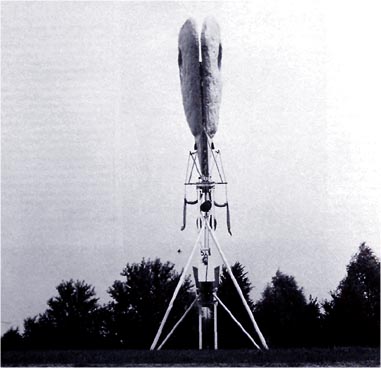 |
 |
 |
THE MACHINE AS A METAPHOR FOR THINKING |
 |
GERRIT VAN BAKEL 1943-1984
1943 born in lJsselsteijn, Brabant lived and worked in Deurne, Brabant
1960 started painting, self-taught
1966-1972 developed ideas on housing and designed furniture 1976 first machine constructions
Exhibitions:
1981 One man show Stedelijk van Abbemuseum, Eindhoven
1982 Dokumenta 7, Kassel, Germany
1984 One man show Stedelijk van Abbemusem, Eindhoven
1985 De Beyerd Breda
Left:
1. Day and Night Machine, 1975-77 (steel, aluminium, polyester, nylon, 810 x 375 x 240 cm)
|
|
 |
Ever since the industrial revolution in the latter half of the 19th century, artists have been using the technical and social phenomenon of the machine in their work. Sometimes their attitude to new techniques was positive and enthusiastic: at other times the size and domination of technical systems were regarded with greater scepticism. In the early 20th century the futurists Marinetti and Boccioni and the constructivists Tatlin and Naum Gabo were among the first to greet the dynamic force of a mechanized society with boundless enthusiasm. They associated the machine image with a positive model for social progress. The work of the constructivists, for example, exhibits the positive spiral of power and progress in their direct use of mechanical propulsion and movement, light reflections and industrial materials.
Artists like Duchamp and Picabia treated the machine metaphorically with their humorous and erotic machine-humans and their parallels with mental or physical mechanisms. The notion of progress coupled with the machine potential reached a climax in the fifties.
Examples are the iron constructions of David Smith and Eduardo Paolozzi. Interest in kinetic and light-art is further proof of an admiring enthusiasm for technical possibilities. Gradually, however, faith in the infinite perfectionism of machine technology has crumbled, the most eloquent expressions of such doubts being Tinguely's ironic machines. With the advent of electronics the simple machine, formerly a symbol of progress and modernity, has become more and more an object of nostalgia.
The technological revolution in terms of electronics, data-processing and computer techniques (a technology more of brain than muscle) demanded a new artistic model. Up to a point it was supplied by conceptual art, the essential basis of which was the systematic conception and encoding of models and structures. It was based to a certain extent on the systems analysis used in advanced technology. Seen in this light, instead of being a symbol of power and progress, the machine became a metaphor of thought: thought and imagination in terms of mental structures and a production system. Dennis Oppenheim's machines and Alice Aycock's more architectonic constructions exemplify this kind of link between mental systems and mechanization. |
 |
The machine that demonstrates these mental functions is more than a formal bond between art and technique. It functions as a poetic equivalent for thought. This broader concept of the machine in art can be specifically applied to the work of Gerrit van Bakel.
Gerrit van Bakel made machines which he preferred to call instruments or simply things. And yet, as we shall see, his machines belong to the world of art. In their own particular way, his works express the specific link between art and technique, between imagination and calculation. The entire phenomenon of inspiration, of hitting on new ideas, is an obscure region. Van Bakel combined the conception and production of his work with poetic imagination: "imposing technique on the new stone age", as he was fond of saying. Art as the poetry of creation, or in modern terminology: the art of technical culture. To him, the notion that a brainwave plus imagination were responsible for inventing the wheel, prove that the artist and the scientist draw essentially on the same source.
His machines are lucid, austere constructions, some of them evoking agricultural machinery, others the frivolous amiability of mechanical gadgetry. Their frequently sluggish, subtle movements enhance the idea of deliberation: you must take your time to look at his machines. His first large construction was the Day and Night Machine (1975/77): sunset in terms of mechanics. It works on the principle of the temperature differences between day and night, and harnesses metal's property of expansion to trigger a mechanical arm. Experiments with temperature fluctuations led to the conclusion that the nocturnal drop in temperature is responsible for daytime heat radiation. This conversion of stored heat into energy means a reversal of day and night, and is rendered visible in the movement of the arm-mechanism. The arms, to which light-blue polyester wings are attached, sink as the temperature drops. They describe a maximum movement of a quarter-circle. An illustration of the semicircular solar orbit is avoided. The sluggish movement indicates that day and night do not exist as diametrical concepts. Day slowly becomes night and vice versa. It is a gradual waxing and waning of light and dark, of heat and cold. The poetic charge of the Day and Night Machine lies in the fusion of technique, physiological phenomenon and imagination. |
 |
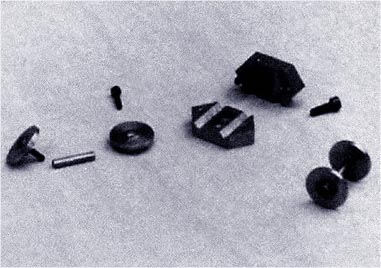 |
 |
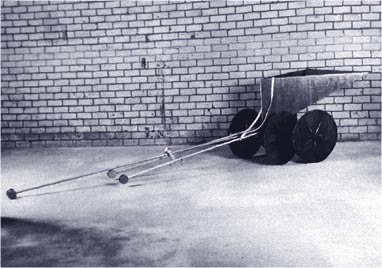 |
|
2. The Seven World Carts, 1982-84 |
 |
3. Rain Cart, 1982-83 (plywood, leather, mohogany, aluminium, steel, lead, 96 x 420 x 122 cm, collection Kröller-Müller Museum, Otterloo |
 |
Van Bakel's idea is that growing consciousness corresponds to the day- and-night reversal mechanism, in other words that thinking about things is a way back to their origin. The slowly unfolding wings convey the idea of developing consciousness. The constantly repeated movement, reflecting the perpetual rhythm of day and night, probes the borders, the horizon of the mind. The repeated motion is that of a hand dusting the border in order to reveal it gradually.
This journey to day's end explores another, poetical space. One is rightly reminded of Panamarenko, whose extremely fragile, lepidopteral machines also forge a link between technical-scientific thought and a reference system of skill and poetry.
The thing about his flying machines, though, is that they delimit and probe the unknown by not functioning.
Right: 4. The Seven World Carts. 1982-84 (steel, copper, messing, aluminium, earth, each 21,6 x 37 x 33 mm, two are respectively in Greece and in Bolivia) |
 |
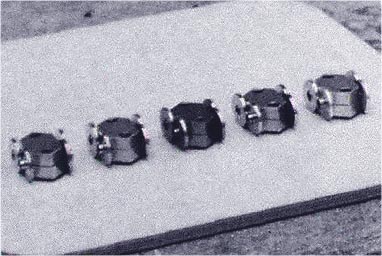 |
 |
Panamarenko the researcher, or perhaps it would be better to call him an 'ingénieur naïf', explores the realm of the imagination in his fantastic dream of flying. He strips science of its usefulness, he plays with it and with gravity. Gerrit van Bakel, however, wanted to return to the source by translating scientific thought into poetry.
Human thought in relation to the laws of nature. His things, the Day and Night Machine in particular, bear witness to the path he pursued. It is a form of self-examination of the urge to make things, a way back to the creative impulse Or as Nietzsche put it, no easy path, but "glattes Eis, ein Paradies für den, der gut zu tanzen Weiş." (1)
Before the laborious path could be marked and charted, he made countless starts on paper: brief notes, scribbles, calculations and more detailed sketches. The final form of a work is heavily indebted to numbers and measurements. The angle of 108 degrees, for instance, is a perpetually recurring factor derived from the structure of carbon dioxide. The atoms of this compound, which results from combustion, form an angle of 108 degrees, an angle also encountered in the Tetrahedron (1982, a triangular pyramid) and the Diamond Scales (1982, a diamond is crystallized carbon). |
 |
Such links between number, size, form and concepts such as energy, heat and costliness, endow his work with a somewhat alchemistic character. It is more than alchemy, though; it is an attempt to translate such ideas into a structure. For what is the value of an abstract number if it bears no relation to a functional meaning? He blamed the technologists up to a point for the rift between number, size and functional meaning. No matter how impressive calculations, diagrams and models may be, they hardly bear a meaningful relationship to their function. At any rate they are far too remote from human beings.
Duchamp once remarked on science's superiority over art: "L'art est la seule chose qui soit restée aux hommes, qui ne veulent pas laisser le dernier mot a la science". (2) In other words, the artist can deprive technology of the last word, not by rejecting it but by proffering the mechanic of the poet. Technology or the poetry of creation. Artists, alchemists, engineers or philosophers can stand side by side when a broader value is placed on the machine - the machine not as a mere production apparatus but as a tool for defining conditions, in analogy to abstract thought and social systems. |
 |
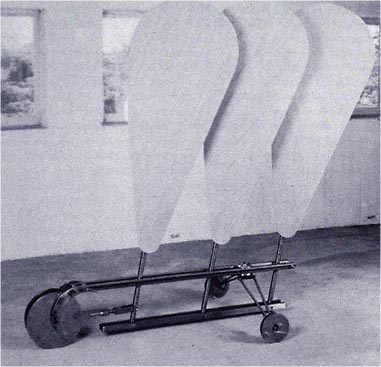 |
 |
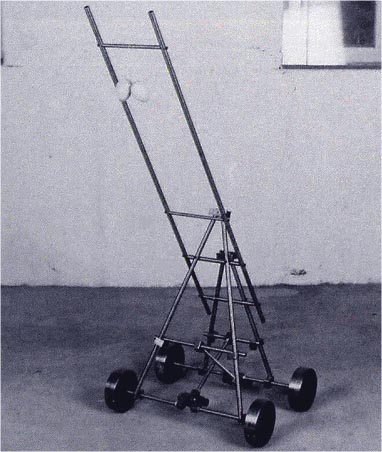 |
|
5. Baldur Chariot, 1984 (steel, aluminium, triplex, ramin, copper, 183 x 159 x 82,5 cm) |
 |
6. The Origin of Piety, 1982 (steel, cotton, eggs, 134 x 57 x 54 cm, collection Centre Pompidou, Paris) |
 |
This confrontation with technique as an extension of thought explains van Bakel's interest in historical inventions and discoveries. Albinoni's Machine (1979/80). for example. refers to an adagio by the 18th-century composer, and Papin's Machine (1980) to the investigator of steam-power. Discoveries from various periods mingle, assembled in a new machine and interpreted anew. It is not a question of a historical vision or retrospect, but chiefly of the encounter and ensuing shock. This assembling and mingling is more like a symbolic encounter with a different age, a different mentality too.
Van Bakel's works frequently have the function of a small vehicle. Often moving sluggishly, they have strange cargoes such as heat, water, diamonds or native soil, conveying the idea of travel and sojourn as an inner movement: all his vehicles transport or carry ideas. The Diamond scales weigh costliness: the Rain-cart collects water, thus becoming a source of power.
Sometimes the cargo is more poetic. Take the Baldur Chariot (1984), whose three averting shields have the task of guarding invulnerability. A counterpart is the little vehicle called 'Over de oorsprong van de Godsvrucht' (The Origin of Piety) (1982) with its insecure ladder leading to the vulnerability of eggs, symbol of natural perfection. Van Bakel's vehicles express, as it were, the artist's inner journey, and in addition tell us something about the capacity or incapacity for contact. This form of travel and sojourn is peculiarly latent in The Seven World Carts (1982-1984), a project whose action and form distance it from the usual communication systems of the art world. It involves transporting a cargo of native soil to seven different countries. His friends were asked to do this, the exact destination being unknown. The carts are made of different metals: iron, copper, aluminium, brass and bronze (two other metals proved unsuitable for manufacturing this form). Each measures 216 x 37 x 33 millimetres and contains soil from the Peel region of the Netherlands, where Van Bakel was born.
Carrying native soil to places he never visited is somewhat reminiscent of Richard Long's journeys. Long does visit a place, though: he marks it visually and brings soil or some other material back with him. |
 |
His verbal, sketched and photographic report, together with his cargo of stones and wood, bear witness to his presence in that place. The ritual character of his presence and physical intervention are comparable to Gerrit van Bakel's carts of native soil. Long is a traveller, however; his work refers to somewhere else, a place where he has actually been. His presence creates a continuity, a progression of the time during which he was there.
Gerrit van Bakel was a traveller in a different, more abstract sense. Transporting native soil, as well as the technological knowhow represented by the carts, is also a form of travel: a symbolic encounter with a different time and a different place. It is a form of travel and encounter similar to what he expressed in his machines: there is no encounter or contact before the click of recognition. The picture his vehicles and machines create enables us to discern and recognize what we have forgotten or do not yet know. This idea of progressing time is a Leitmotiv in his work. It is why the new is never entirely new, for it is always preceded by a dream.
Gerrit van Bakel's machines are the visible result of pottering with concepts: the machine or the poetry of creation. An example is his object with the somewhat obscure title of Medium-Sized Problem Carrier (1984). The problems being carried seem to be summarized in the image of the bow, which can be interpreted as an object and weapon, as well as symbolizing an arch over the idea. This latter aspect, in particular, seems in van Bakel's mental world to weigh so heavily on the object that the axle of the wheels supporting the bow sags. The slanting angle of the flat wheels underlines the moment of equilibrium, and the diagonal line of the bow - soaring up from the ground below - suggests rarefied heights. Van Bakel's objects exhibit a blend of security and distance, not least by their minute attention to detail. They make one feel sure of the great comfort that inaccessibility can provide. By endeavouring to reach it, we preserve our hopes. Isn't that a tremendous miracle?
Irene Veenstra |
 |
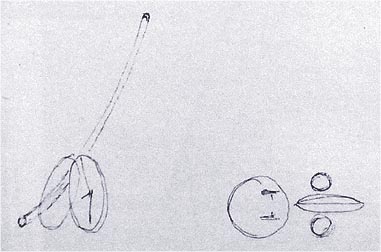 |
 |
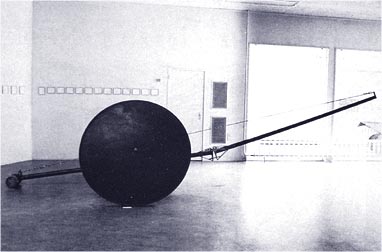 |
|
7. drawings from a sketchbook, 1984 |
 |
8. Medium-Sized Problem Carrier, 1984 (steel, steel rope, 133 x 630 x 216 cm, collection Kröller-Müller Museum, Otterlo) |
 |
This is a modified version of an article published in Metropolis M. 1984, #6
Notes:
1) Slippery ice, paradise to the skilled dancer
2) Art is the only thing left to those who do not want to give science the last word.
|
 |